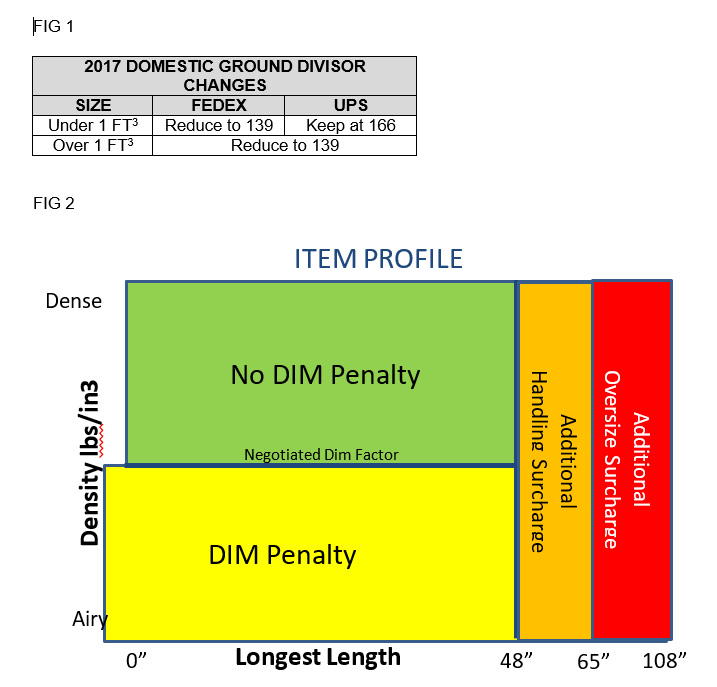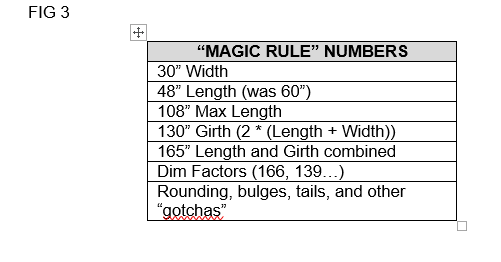This article originally appeared in the May/June issue of PARCEL.
Many supply chains have been struggling to control costs and maintain budgets under the new dimensional (DIM) calculations put in place by FedEx and UPS. Those changes, introduced as part of the 2017 General Rate Increase (Figure 1), decrease DIM factors, add accessorials, and apply DIM surcharges against a larger pool of packages.

While carrier negotiations around DIM factors and surcharges postpone some financial impact, there are additional ways to mitigate and even eliminate DIM surcharges from your operation.
PROFILE YOUR DIM
Review recent invoices to estimate the magnitude of DIM surcharges. Key fields to look at are billed weight versus scale weight and the handling accessorials are being applied.
Dimensional surcharges have three root causes:
· Item level DIM based on the inherent nature of what you sell
· Package level DIM based on how efficiently you overbox and/or overbag
· Order level DIM based on how customers order and how orders get fulfilled in your operation
Plot every item sold on the above item surcharge grid (Figure 2), which looks at a product’s longest length and density. This grid assumes a single ship item, as is, without any additional packaging.
Items plotted in the green shaded area are dense enough and short enough to avoid dimensional penalties. The remaining “trouble” items appearing in other sections of the grid incur one or more costly surcharges.
Long term, trouble items represent your core dimensional dilemma, which is largely a function of the products you choose to sell. Perform additional plots to recreate this analysis at the shipment and order level and incorporate additional volumetric surcharges like girth.
Share this analysis upwards and across your organization. It raises key questions about the items that are sold, how they come packaged from suppliers, the pricing that is sought from customers, and the profitability of selling DIM items.
WORK WITH YOUR SUPPLIERS
Recognize the diminished role retail packaging plays in an internet world. Where possible, work with suppliers to remove excess packaging, consolidate accessory boxes, and eliminate dead space.
Focus on minimizing the largest offending dimensions of trouble items. This may involve disassembly, compression, nesting, and hiding. Opportunities found here are win-wins because they increase both storage and shipping density for suppliers and shippers.
Educate your internal supply chain and key suppliers on the “magic rule” numbers (Figure 3) that trigger dimensional surcharges and impact margins. Encourage your supply chain partners to design for item level compliance.

Finally, evaluate the suitability of DIM items to drop ship from the supplier and assess if the existing packaging can safely ship alone without overboxing. Invest in packaging to reduce transportation costs. This gives your shipping department the flexibility to choose how best to fulfill an order.
EDUCATE AND INCENT YOUR CUSTOMERS
Customers typically don’t appreciate the nuances of shipping difficult products but can be persuaded to change behavior through incentives and promotions. One powerful way to both increase revenues and decrease shipping costs is to upsell.
Share with your marketing and sales department two quick-win opportunities for items that have a large dimensional (billed > scale) weight component or high DIM accessorials:
· Buy more. Similarly dimensioned items likely can be nested or offset, providing more weight with little expansion of the overall cube.
· Ride for free. Heavier compatible items that fit in the same overbox incur no additional shipping charge if their weight is less than the DIM surcharge.
Apply incentives opportunistically at checkout or proactively through email promotions. Taken together, the total shipping cost per item is reduced and profitability increased.
ADOPT OPTIMAL PACKAGING
Optimal packaging attacks the cost of fulfilling the entire order by minimizing total cost components such as transportation, packaging, void fill, and warehouse labor. It has two key sub-components: cartonization routines and the carton regime.
Cartonization is the process around matching ordered items to shippers. Successful algorithms have high fill percentages and minimize the human element of picking the wrong shipper(s) for the order.
Cartonization algorithms need correct data and parameters to operate effectively. A key data input is the “footprint,” which represents the longest side of an item. Evaluate every item’s footprint against your available boxes. Look for long footprint items that have no choice but to be forced into higher cube boxes.
Remove or tape down excess packaging such as hanger tabs and bag tails when capturing an item’s dimensions. Also fold or roll clothes, pack slips, instructions, and catalogs. This prevents artificially large item dimensions from biasing the overbox selection.
The carton buffer percentage is a key parameter that limits how much to put in a carton before it is full. Consider a new technique called granulated buffering, which dynamically adjusts the carton buffer based on the granularity of the order. Larger items (boulders) get larger percentages and smaller items (sand) get small percentages. This allows more product to go into a carton versus traditional static buffers.
Next, evaluate your carton regime in light of your specific order profile. The carton regime is the collection of boxes and bags used to package an order. More package choices usually lead to reductions in DIM charges. Tailor your carton regimes’ volume and dimensions to your specific order and item profiles and avoid general sized boxes.
Consider “on-demand” packaging if your business involves a large number of items that are dimensionally different. The on-demand approach reduces packaging DIM by building a customized box. Some key advantages are less DIM, increased sustainability, and a reduction in the number of boxes stocked.
Lastly, shippers must have a dimensionally efficient gift fulfillment strategy. Avoid tactics that add significant cube to a gift order. In-lieu donations encourage customers to eliminate gift boxing while traditional gift wrap, gift bags, and premium printed shippers can provide a DIM-compatible customer experience.
Dimensional surcharges have been steadily increasing over the years and are now a painful fact of life for many shippers. Profiling your dimensional surcharges, working with suppliers and customers, and adopting new methods are crucial to staying controlling costs and staying under budget.
Jeffrey Haushalter is Partner, Chicago Consulting. He focuses on helping his clients manage their warehouse operations, parcel spend management, transportation optimization, and more. Contact him at jeff@chicago-consulting.com.

















